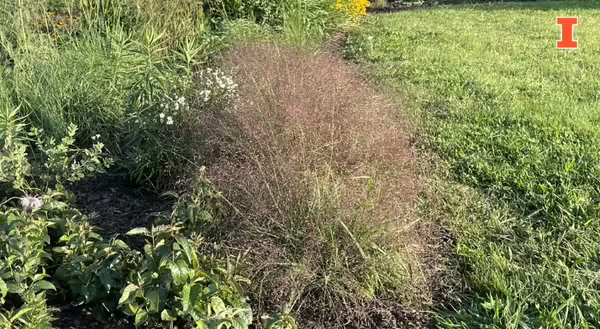
Grasses are an often-underappreciated component of landscaping. They don’t have the showy flowers of many forbs and are thus overlooked. But when it comes to keeping out weeds, adding structure and winter interest, or preventing erosion, you won’t find much better than grasses.
While turf is likely what comes to mind when “grass” is mentioned, grasses take many different forms, such as mounding or upright. There are warm-season and cool-season grasses, with the former growing more during summer and the latter growing more in spring and fall. Some grasses are native, while some are not, and some are downright invasive. Let’s take a look at some popular ornamental grasses and maybe some you’ve never heard of that can live in northern Illinois.
Prairie Dropseed
One of my favorite native options for grasses is prairie dropseed (Sporobolus heterolepis). Dropseed is a fine-textured, fountaining kind of grass that grows up before gracefully arching down. It’s perfect for larger areas that can handle the mounds, which can reach 15-18” across. In later summer, the tiny flowers form fragrant panicles, with a scent that seems to vary by person, but is often described as smelling like popcorn or melted wax. It turns a lovely golden-bronze in the winter, adding winter interest.
Purple Lovegrass
An adorable plant needs an adorable name. I recently added some purple lovegrass (Eragrostis spectabilis) to my landscaping and it’s amazing. The fluffy, purple cloud-like seed heads provide interesting contrast throughout the bed. This low-growing bunchgrass prefers drier, well-drained soils, and will tolerate poorer soils.
Blue Gramma Grass
Another new addition to my home landscaping is Blue Gramma Grass (Bouteloua gracilis). A lower-growing native grass that is drought-resistant, Blue Gramma Grass produces tall seed heads that resemble a pennant. It can be used as erosion control or a lawn substitute, but because it’s a warm-season grass, it does need some companion plantings to keep the spring weeds at bay. It likes dry, well-drained locations in full sun.
Feather Reed Grass (Karl Foerster grass)
This popular ornamental grass can be used almost anywhere except full shade. Feather reed grass (Calamagrostis x acutiflora ‘Karl Foerster’) or simply “Karl Foerster grass” likes rich, moist soils but can also tolerate clay. Named after a German nurseryman, this grass has few problems with insects or disease. It makes a nice accent grass for its height and feather-like flowering stalks that are tan or gold. Though its parentage comes from Europe and Asia (it’s a cross between two species), the seeds are sterile and no invasive tendencies have been shown.